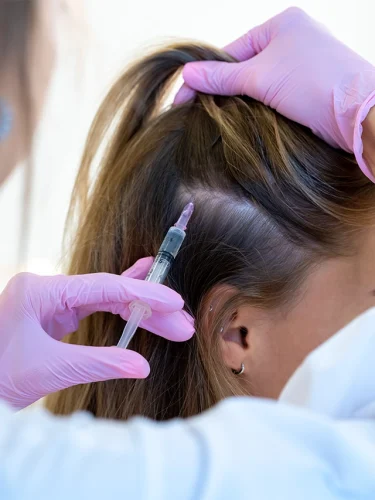Last Updated on March 28, 2025

In a world where appearance can significantly influence first impressions, having a full head of hair is often seen as a symbol of youth and vitality. However, for many, the unexpected onset of hair thinning disrupts this image and profoundly affects one’s self-confidence and emotional well-being.
While hair loss is a prevalent concern, it’s crucial to understand its diverse causes and the varying effectiveness of intervention methods. Proactive measures, including trusted hair care hacks and practices, can mitigate hair thinning and foster scalp health, particularly in cases where hair loss is not genetically predetermined. For hereditary conditions like androgenetic alopecia, however, these approaches may offer limited results, and medical or surgical interventions often play a more significant role.
This guide provides detailed, discerning insights into the intricacies of hair restoration surgery, offering a comprehensive overview of the procedures, hair transplant costs, and techniques employed. It ensures that individuals are well-informed and ready to navigate their surgical hair rejuvenation journey confidently and clearly.
Understanding Hair Loss
The journey to consider hair restoration starts with the unsettling discovery of hair shedding, a condition influenced by many factors.
- Genetic predisposition – Often the primary actor, hereditary conditions like androgenetic alopecia manifest as a receding hairline in men and thinning hair in women.
- Hormonal fluctuations – Shifts in the body’s hormonal balance due to pregnancy, menopause, or thyroid issues can significantly affect hair growth.
- Medical conditions – Illnesses that attack the immune system, such as alopecia areata, or systemic treatments like chemotherapy, can lead to hair shedding
- Medications – Certain drugs for blood pressure, depression, and arthritis, among others, may list losing hair as a potential side effect.
- Nutritional deficiencies – Insufficient protein, iron, and other nutrients can impair hair growth and increase shedding.
- Stress – Both physical and emotional stress can push hair follicles into a resting phase, reducing the number of hairs in active growth.
- Hair care practices – Tight hairstyles, harsh chemicals, and excessive heat styling can contribute to traction alopecia and breakage.
- Environmental factors – Exposure to pollutants and sun damage can weaken hair and exacerbate thinning.
Evaluating your specific condition could lead to manageable solutions, but what about cases where it’s irreversible? Considering a hair restoration procedure then becomes an investment in your self-esteem – but have you explored what such a transformation might entail, particularly the hair transplant cost Chicago or in your state?
What Is A Hair Transplant?
A hair transplant is a surgical procedure designed to restore hair to areas affected by thinning or baldness by transferring hair follicles from denser regions to those in need. This procedure comes in two primary forms:
- Follicular Unit Transplantation (FUT) – Here, surgeons remove a strip of hair-bearing skin from a donor area and transplant individual follicles to the balding zones.
- Follicular Unit Extraction (FUE) – This method involves extracting individual hair follicles directly from the donor site and meticulously placing them in areas affected by thinning.
Selecting FUT or FUE hair restoration techniques is guided by individual hair thinning patterns and lifestyle, ideal for those with stable baldness and ample donor hair. Beyond these standard methods, other options are available. Having realistic expectations and viewing surgery as part of a holistic hair care regimen is vital, necessitating a dedicated investment of time and resources.
Hair Transplant Cost
When considering a transplant, one of the primary considerations is the hair transplant cost. The expense varies widely, influenced by several key factors. This section explores these variables, offering insight into what one might expect to invest in this life-changing procedure.
- Type of procedure – Choosing between Follicular Unit Transplantation (FUT) and Follicular Unit Extraction (FUE) significantly impacts hair transplant cost. Generally, FUE, being more advanced and less invasive, commands a higher price than FUT.
- The extent of hair loss and grafts required – The number of grafts needed to achieve desired results directly influences the total cost. More extensive hair loss necessitates more grafts, increasing the price.
- Surgeon’s expertise and reputation – Renowned surgeons and clinics often charge more due to their expertise and higher success rates. Choosing a reputable professional ensures quality but may come with a higher price tag.
- Geographical location – The clinic’s location plays a substantial role in determining cost. Clinics in metropolitan areas or countries known for medical tourism often have higher pricing structures.
- Additional treatments and services – Clinicians may sometimes recommend supplementary treatments like Platelet-Rich Plasma (PRP) therapy or post-operative care packages, contributing to the total expense.
- Post-operative care and medication – Aftercare, including drugs and follow-up visits, can also contribute to the overall expense. While some clinics include these in their package, others may charge separately.
It’s essential to remember that while hair transplant cost is a significant factor, it should not be the sole consideration. The quality of the procedure, the surgeon’s experience, and the likelihood of achieving desired outcomes should also weigh heavily in the decision-making process.
Preparing For A Hair Transplant
Careful planning is crucial to ensuring the best outcome from a surgical hair restoration process. Here’s what to consider before taking the plunge:
- Medical evaluation and consultation – A thorough assessment with a hair restoration expert is crucial to discuss your health history, the progression of your hair thinning and to set attainable expectations for the procedure.
- Physical preparation – Before surgery, you’ll need to avoid certain medications and supplements that could increase bleeding, stop smoking to improve healing outcomes, and reduce alcohol intake to decrease potential post-operative swelling.
- Mental and emotional preparation – It’s essential to mentally gear up for the recovery period, recognize that results take time to manifest, and gather a support system to help you through the post-procedure phase.
These initial steps can significantly streamline your journey towards hair restoration surgery, ensuring a fulfilling and trouble-free process.
The Hair Transplant Procedure
Surgically restoring hair doesn’t require an overnight hospital stay, allowing patients to leave and recover at home on the same day.
- Initial steps –The process begins with the surgeon numbing the scalp using local anesthesia. Then, the surgeon proceeds with the extraction of hair follicles.
- Follicle extraction – In FUT, surgeons excise a strip of scalp from the donor area and meticulously separate individual hair follicles. In FUE, they harvest each follicular unit directly from the scalp using a specialized punch device.
- Recipient site preparation – The surgeon then prepares the recipient area, creating tiny incisions in the scalp to receive the extracted follicles.
- Transplantation –The extracted follicles are then carefully inserted into the prepared incisions.
- Closure and dressing – If using the FUT method, surgeons suture the donor area closed after removing the strip and typically bandage the head, providing instructions for at-home care.
In the hands of a skilled professional, this surgical restoration can significantly enhance hair density and overall appearance. Still, it’s meticulous preparation, precise execution, and proper aftercare that genuinely ensure the longevity and success of the procedure.
Recovery And Aftercare
Post-operative care is a crucial aspect of the surgical hair restoration journey. Here’s what you need to know:
- Immediate post-procedure- Recovery starts immediately after the procedure, with patients likely to encounter some tenderness and swelling, which they can manage with prescribed medication.
- Hair washing and scalp care – Generally, gentle washing can begin after a few days, using a mild shampoo to avoid irritation.
- Activity restrictions – You should avoid vigorous activities for at least a week to prevent increased swelling and bleeding.
- Monitoring and follow-up – Regular follow-up appointments are necessary to ensure proper healing and track hair growth progress.
- Long-term care – Protecting the scalp from the sun and avoiding harsh chemical treatments for a specified period post-procedure is recommended.
Effective aftercare plays a vital role in ensuring the favorable outcome of the surgical hair restoration process. Adherence to the recovery protocol, patience, and proper scalp care paves the way for a fuller, natural-looking head of hair.
Risks And Considerations
A hair transplant, while promising rejuvenation, carries inherent risks such as infection and scarring, with success partly hinging on the surgeon’s expertise for natural-looking results.
Post-procedure discomfort and the potential for financial strain due to its cost and the prospect of additional future treatments necessitate a detailed discussion with a seasoned surgeon to ensure expectations are well-grounded.
Final Thoughts
The decision to undergo hair restoration surgery is as much about reclaiming your confidence as restoring your hair. It’s a step towards the image you envision for yourself, taken with careful consideration and guided by expert hands. If you’re ready to take that step, seek a consultation to explore your path to hair restoration. Your journey to a fuller head of hair and renewed self-assurance is just a conversation away.
Olaplex Review: Exploring the Hype Behind the Haircare Treatment Kim K & JLO Live For
Our Favorite Things From Lush: Shampoo Bars, Lush Bath Bombs, and More
The Best Hair Care Products to Save Your Hair and Give It a Healthy Glow
The Ultimate Hair Makeover Featuring Our Favorite Celebrities
How long do hair transplants last?
Roughly three months later (within a span of 90 to 100 days), fresh hair begins to emerge and maintains a regular growth pace. Around six months following a hair transplant procedure, the transplanted hairs start to adopt a natural look and will persistently grow throughout a person’s lifetime.
Can you still go bald after a hair transplant?
It is improbable that you will experience a recurrence of baldness following the surgery, given the nature of the harvested follicles.
How expensive is a hair transplant?
The expense is $10,000, with the cost varying between $3,000 and over $15,000 based on various factors related to the treatment. Charges may apply for individual services within your treatment or as part of a comprehensive package.
- Successible Life Staffhttps://successiblelife.com/author/successible-life-staff/
- Successible Life Staffhttps://successiblelife.com/author/successible-life-staff/
- Successible Life Staffhttps://successiblelife.com/author/successible-life-staff/
- Successible Life Staffhttps://successiblelife.com/author/successible-life-staff/




